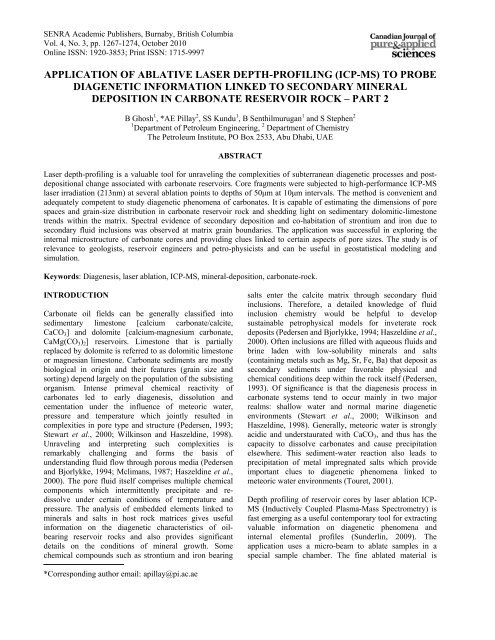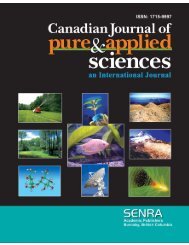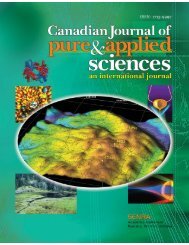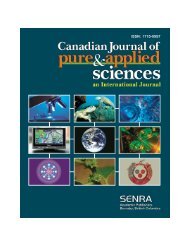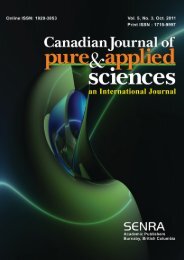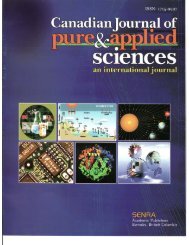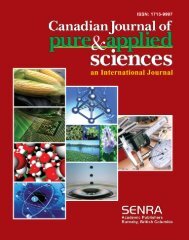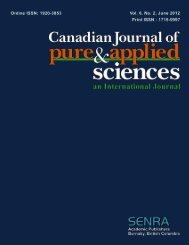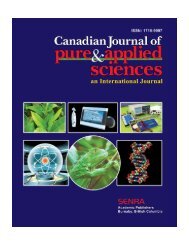Oct-10 - Canadian Journal of Pure and Applied Sciences
Oct-10 - Canadian Journal of Pure and Applied Sciences
Oct-10 - Canadian Journal of Pure and Applied Sciences
You also want an ePaper? Increase the reach of your titles
YUMPU automatically turns print PDFs into web optimized ePapers that Google loves.
SENRA Academic Publishers, Burnaby, British Columbia<br />
Vol. 4, No. 3, pp. 1267-1274, <strong>Oct</strong>ober 20<strong>10</strong><br />
Online ISSN: 1920-3853; Print ISSN: 1715-9997<br />
1<br />
APPLICATION OF ABLATIVE LASER DEPTH-PROFILING (ICP-MS) TO PROBE<br />
DIAGENETIC INFORMATION LINKED TO SECONDARY MINERAL<br />
DEPOSITION IN CARBONATE RESERVOIR ROCK – PART 2<br />
B Ghosh 1 , *AE Pillay 2 , SS Kundu 1 , B Senthilmurugan 1 <strong>and</strong> S Stephen 2<br />
1 Department <strong>of</strong> Petroleum Engineering, 2 Department <strong>of</strong> Chemistry<br />
The Petroleum Institute, PO Box 2533, Abu Dhabi, UAE<br />
ABSTRACT<br />
Laser depth-pr<strong>of</strong>iling is a valuable tool for unraveling the complexities <strong>of</strong> subterranean diagenetic processes <strong>and</strong> postdepositional<br />
change associated with carbonate reservoirs. Core fragments were subjected to high-performance ICP-MS<br />
laser irradiation (213nm) at several ablation points to depths <strong>of</strong> 50µm at <strong>10</strong>µm intervals. The method is convenient <strong>and</strong><br />
adequately competent to study diagenetic phenomena <strong>of</strong> carbonates. It is capable <strong>of</strong> estimating the dimensions <strong>of</strong> pore<br />
spaces <strong>and</strong> grain-size distribution in carbonate reservoir rock <strong>and</strong> shedding light on sedimentary dolomitic-limestone<br />
trends within the matrix. Spectral evidence <strong>of</strong> secondary deposition <strong>and</strong> co-habitation <strong>of</strong> strontium <strong>and</strong> iron due to<br />
secondary fluid inclusions was observed at matrix grain boundaries. The application was successful in exploring the<br />
internal microstructure <strong>of</strong> carbonate cores <strong>and</strong> providing clues linked to certain aspects <strong>of</strong> pore sizes. The study is <strong>of</strong><br />
relevance to geologists, reservoir engineers <strong>and</strong> petro-physicists <strong>and</strong> can be useful in geostatistical modeling <strong>and</strong><br />
simulation.<br />
Keywords: Diagenesis, laser ablation, ICP-MS, mineral-deposition, carbonate-rock.<br />
INTRODUCTION<br />
Carbonate oil fields can be generally classified into<br />
sedimentary limestone [calcium carbonate/calcite,<br />
CaCO 3 ] <strong>and</strong> dolomite [calcium-magnesium carbonate,<br />
CaMg(CO 3 ) 2 ] reservoirs. Limestone that is partially<br />
replaced by dolomite is referred to as dolomitic limestone<br />
or magnesian limestone. Carbonate sediments are mostly<br />
biological in origin <strong>and</strong> their features (grain size <strong>and</strong><br />
sorting) depend largely on the population <strong>of</strong> the subsisting<br />
organism. Intense primeval chemical reactivity <strong>of</strong><br />
carbonates led to early diagenesis, dissolution <strong>and</strong><br />
cementation under the influence <strong>of</strong> meteoric water,<br />
pressure <strong>and</strong> temperature which jointly resulted in<br />
complexities in pore type <strong>and</strong> structure (Pedersen, 1993;<br />
Stewart et al., 2000; Wilkinson <strong>and</strong> Haszeldine, 1998).<br />
Unraveling <strong>and</strong> interpreting such complexities is<br />
remarkably challenging <strong>and</strong> forms the basis <strong>of</strong><br />
underst<strong>and</strong>ing fluid flow through porous media (Pedersen<br />
<strong>and</strong> Bjorlykke, 1994; Mclimans, 1987; Haszeldine et al.,<br />
2000). The pore fluid itself comprises multiple chemical<br />
components which intermittently precipitate <strong>and</strong> redissolve<br />
under certain conditions <strong>of</strong> temperature <strong>and</strong><br />
pressure. The analysis <strong>of</strong> embedded elements linked to<br />
minerals <strong>and</strong> salts in host rock matrices gives useful<br />
information on the diagenetic characteristics <strong>of</strong> oilbearing<br />
reservoir rocks <strong>and</strong> also provides significant<br />
details on the conditions <strong>of</strong> mineral growth. Some<br />
chemical compounds such as strontium <strong>and</strong> iron bearing<br />
salts enter the calcite matrix through secondary fluid<br />
inclusions. Therefore, a detailed knowledge <strong>of</strong> fluid<br />
inclusion chemistry would be helpful to develop<br />
sustainable petrophysical models for inveterate rock<br />
deposits (Pedersen <strong>and</strong> Bjorlykke, 1994; Haszeldine et al.,<br />
2000). Often inclusions are filled with aqueous fluids <strong>and</strong><br />
brine laden with low-solubility minerals <strong>and</strong> salts<br />
(containing metals such as Mg, Sr, Fe, Ba) that deposit as<br />
secondary sediments under favorable physical <strong>and</strong><br />
chemical conditions deep within the rock itself (Pedersen,<br />
1993). Of significance is that the diagenesis process in<br />
carbonate systems tend to occur mainly in two major<br />
realms: shallow water <strong>and</strong> normal marine diagenetic<br />
environments (Stewart et al., 2000; Wilkinson <strong>and</strong><br />
Haszeldine, 1998). Generally, meteoric water is strongly<br />
acidic <strong>and</strong> understaurated with CaCO 3 , <strong>and</strong> thus has the<br />
capacity to dissolve carbonates <strong>and</strong> cause precipitation<br />
elsewhere. This sediment-water reaction also leads to<br />
precipitation <strong>of</strong> metal impregnated salts which provide<br />
important clues to diagenetic phenomena linked to<br />
meteoric water environments (Touret, 2001).<br />
Depth pr<strong>of</strong>iling <strong>of</strong> reservoir cores by laser ablation ICP-<br />
MS (Inductively Coupled Plasma-Mass Spectrometry) is<br />
fast emerging as a useful contemporary tool for extracting<br />
valuable information on diagenetic phenomena <strong>and</strong><br />
internal elemental pr<strong>of</strong>iles (Sunderlin, 2009). The<br />
application uses a micro-beam to ablate samples in a<br />
special sample chamber. The fine ablated material is<br />
*Corresponding author email: apillay@pi.ac.ae


